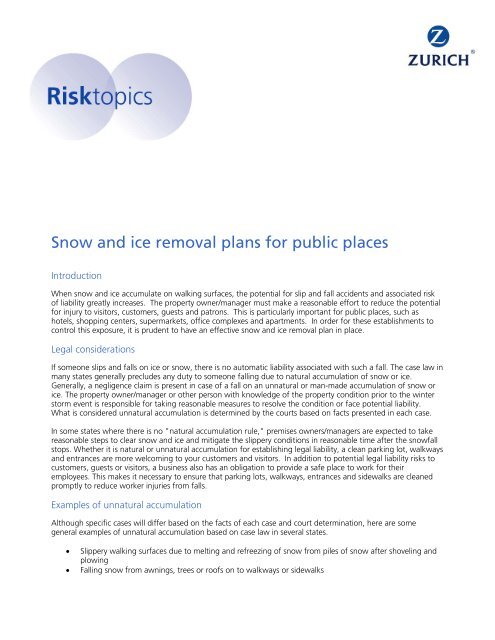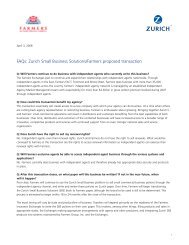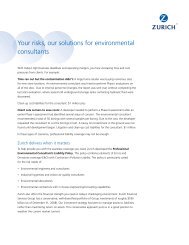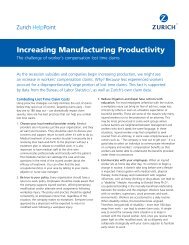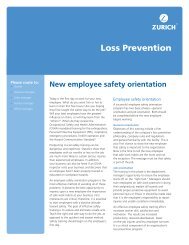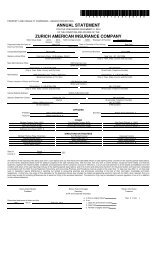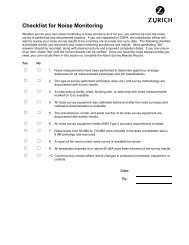Snow and ice removal plans for public places - Zurich
Snow and ice removal plans for public places - Zurich
Snow and ice removal plans for public places - Zurich
Create successful ePaper yourself
Turn your PDF publications into a flip-book with our unique Google optimized e-Paper software.
<strong>Snow</strong> <strong>and</strong> <strong>ice</strong> <strong>removal</strong> <strong>plans</strong> <strong>for</strong> <strong>public</strong> <strong>places</strong><br />
Introduction<br />
When snow <strong>and</strong> <strong>ice</strong> accumulate on walking surfaces, the potential <strong>for</strong> slip <strong>and</strong> fall accidents <strong>and</strong> associated risk<br />
of liability greatly increases. The property owner/manager must make a reasonable ef<strong>for</strong>t to reduce the potential<br />
<strong>for</strong> injury to visitors, customers, guests <strong>and</strong> patrons. This is particularly important <strong>for</strong> <strong>public</strong> <strong>places</strong>, such as<br />
hotels, shopping centers, supermarkets, off<strong>ice</strong> complexes <strong>and</strong> apartments. In order <strong>for</strong> these establishments to<br />
control this exposure, it is prudent to have an effective snow <strong>and</strong> <strong>ice</strong> <strong>removal</strong> plan in place.<br />
Legal considerations<br />
If someone slips <strong>and</strong> falls on <strong>ice</strong> or snow, there is no automatic liability associated with such a fall. The case law in<br />
many states generally precludes any duty to someone falling due to natural accumulation of snow or <strong>ice</strong>.<br />
Generally, a negligence claim is present in case of a fall on an unnatural or man-made accumulation of snow or<br />
<strong>ice</strong>. The property owner/manager or other person with knowledge of the property condition prior to the winter<br />
storm event is responsible <strong>for</strong> taking reasonable measures to resolve the condition or face potential liability.<br />
What is considered unnatural accumulation is determined by the courts based on facts presented in each case.<br />
In some states where there is no "natural accumulation rule," premises owners/managers are expected to take<br />
reasonable steps to clear snow <strong>and</strong> <strong>ice</strong> <strong>and</strong> mitigate the slippery conditions in reasonable time after the snowfall<br />
stops. Whether it is natural or unnatural accumulation <strong>for</strong> establishing legal liability, a clean parking lot, walkways<br />
<strong>and</strong> entrances are more welcoming to your customers <strong>and</strong> visitors. In addition to potential legal liability risks to<br />
customers, guests or visitors, a business also has an obligation to provide a safe place to work <strong>for</strong> their<br />
employees. This makes it necessary to ensure that parking lots, walkways, entrances <strong>and</strong> sidewalks are cleaned<br />
promptly to reduce worker injuries from falls.<br />
Examples of unnatural accumulation<br />
Although specific cases will differ based on the facts of each case <strong>and</strong> court determination, here are some<br />
general examples of unnatural accumulation based on case law in several states.<br />
• Slippery walking surfaces due to melting <strong>and</strong> refreezing of snow from piles of snow after shoveling <strong>and</strong><br />
plowing<br />
• Falling snow from awnings, trees or roofs on to walkways or sidewalks
• Freezing of water runoff from roof downspouts or gutters<br />
• Puddles <strong>and</strong> refreezing of snow <strong>and</strong> <strong>ice</strong> on walking surfaces<br />
• Icy conditions (black <strong>ice</strong>) on well-traveled paths with foot or vehicular traffic<br />
• Plowing <strong>and</strong> piling of snow causing hazardous conditions, such as visibility obstruction<br />
Management considerations<br />
In order to help mitigate liability risks <strong>for</strong> snow <strong>and</strong> <strong>ice</strong> falls or <strong>for</strong> courtesies to customers <strong>and</strong> visitors to your<br />
premises, business <strong>and</strong> premises owners/managers should have a snow <strong>and</strong> <strong>ice</strong> <strong>removal</strong> plan. This is particularly<br />
important <strong>for</strong> businesses that have customers, invited guests <strong>and</strong> other visitors coming on your premises. <strong>Snow</strong><br />
<strong>removal</strong> is also important <strong>for</strong> reducing employee falls. You may decide to use a contractor <strong>for</strong> snow <strong>removal</strong> or<br />
use in-house resources <strong>and</strong> personnel to accomplish this. If you decide to undertake this task in-house, ensure<br />
that you have adequate personnel, procedures, supplies <strong>and</strong> equipment in place. <strong>Snow</strong> <strong>removal</strong> may be necessary<br />
at early hours be<strong>for</strong>e opening of business <strong>and</strong> several times during the day <strong>and</strong> night. In either case, planning is<br />
essential.<br />
In addition, the plan should include procedures <strong>for</strong> h<strong>and</strong>ling incidents <strong>and</strong> claims, including need <strong>for</strong> immediate<br />
medical assistance <strong>and</strong> claims notification, documentation <strong>and</strong> prompt investigation.<br />
<strong>Snow</strong> <strong>removal</strong> should focus on walkways, parking, entrances <strong>and</strong> other high pedestrian traffic areas. In addition<br />
to snow <strong>removal</strong>, care must be taken to ensure good walking conditions by proper salting <strong>and</strong> to mitigate<br />
slippery conditions from refreezing of snow. Consider using calcium chloride instead of rock salt. Although more<br />
expensive, calcium chloride is more effective at lower temperatures <strong>and</strong> also less harmful to concrete <strong>and</strong><br />
l<strong>and</strong>scaping.<br />
Additional considerations should include:<br />
• Development <strong>and</strong> implementation of a written plan that outlines the responsible person <strong>for</strong> coordination,<br />
contractor selection guidelines, frequency <strong>and</strong> procedures <strong>for</strong> snow <strong>removal</strong>.<br />
• Monitoring of weather in<strong>for</strong>mation <strong>and</strong> recording of pertinent data on snow <strong>removal</strong> log. The log should<br />
include details such as estimated snow accumulation, <strong>ice</strong> build-up, temperature, action taken (e.g. date<br />
<strong>and</strong> time contractor called, plow used, salt applied), inspection notes <strong>and</strong> any unusual conditions.<br />
Fluctuating temperature can lead to refreezing <strong>and</strong> hazardous conditions.<br />
• Posting of warnings in high-hazard areas. Remove or provide warnings of "hidden" hazards that could<br />
be inadvertently struck by cars or pedestrians if covered by snow (fire hydrants, curbs, grates <strong>and</strong> debris<br />
in walkway).<br />
• High piles of snow can also reduce visibility around corners. Melting of snow from piles adjacent to a<br />
walkway can result in refreezing of water on the walkway.<br />
• Consider engineering controls like heated walking surfaces when practical. Relocate downspouts if they<br />
discharge water onto walking surfaces.<br />
• Excessive salt <strong>and</strong> s<strong>and</strong> used in the treatment can be tracked indoors resulting in possible damage to<br />
carpets <strong>and</strong> floor surfaces <strong>and</strong> can even cause a potential slip <strong>and</strong> fall hazard.<br />
Case study<br />
This case involves injuries to a hotel guest in a suburban Minneapolis hotel parking lot. After several inches of<br />
snow fell early on a spring day, it was removed from the parking lot. A couple of days later, after a late night<br />
check-in, a guest fell on <strong>ice</strong> while getting out of the car in the parking lot. The fall resulted in serious injuries<br />
including a fractured leg. Unable to get in the rear entrance, he finally crawled back 200 feet to the car <strong>and</strong><br />
drove to the front of the hotel <strong>for</strong> help. Weather records <strong>for</strong> the day of the accident indicated a high<br />
temperature of 37 º F at 3:00 p.m. <strong>and</strong> the temperature dropping to 28 º F by midnight.<br />
This variation in temperature was sufficient to cause a thaw <strong>and</strong> refreeze in the parking lot area.<br />
The jury found the guest 20 percent liable due to his intoxicated condition. Jurors found the hotel 80 percent<br />
liable, awarding the hotel guest $243,000 <strong>for</strong> his injuries.
The Minnesota Court of Appeals ruled that because the hotel ". . . invites guests to stay in its hotel <strong>and</strong> is aware<br />
that its guests will park in its lot <strong>and</strong> walk from the lot to the hotel, ... [it] has a duty as matter of law to its<br />
patrons, to provide safe access from its parking lot to its building. It was entirely reasonable <strong>for</strong> the jury to<br />
consider [the hotel's] failure to salt <strong>and</strong> s<strong>and</strong> a breach of duty of reasonable care under the circumstances<br />
particularly in Minnesota after a substantial snowfall in early spring where the temperature was fluctuating above<br />
<strong>and</strong> below freezing . . ." (Myers v. Winslow R. Chamberlain Co., 443 N.W. 2nd Minn., 1991).<br />
Case study considerations<br />
In reviewing the above case study, the following are some of the questions that can be raised:<br />
• Was the snow/<strong>ice</strong> accumulation natural or unnatural based on the case law in the state?<br />
• Was there a snow <strong>removal</strong> plan?<br />
• Is it "reasonable" given the geographic location <strong>and</strong> past history of snowfall in the area?<br />
• Was the plan followed <strong>and</strong> actions documented?<br />
Some local ordinances may allow up to 24 hours <strong>for</strong> removing snow/<strong>ice</strong> from the sidewalks <strong>and</strong> in front of the<br />
premises. Compliance with such regulations may not diminish the liability <strong>for</strong> snow/<strong>ice</strong> related accidents. A<br />
violation, on the other h<strong>and</strong>, is likely to result in statutory fines <strong>and</strong> may provide evidence of negligence. Either<br />
having a plan <strong>and</strong> not following it or not having any plan at all will have the same adverse impact <strong>and</strong> will most<br />
likely strengthen a negligence allegation.<br />
The determination of what is considered reasonable ef<strong>for</strong>ts in snow <strong>removal</strong> will depend upon specific facts <strong>and</strong><br />
circumstances. It would be unreasonable to expect parking lots <strong>and</strong> walkways to be free of snow/<strong>ice</strong> in the<br />
middle of a blizzard. However, it is reasonable to expect a property owner to remove the snow/<strong>ice</strong> promptly once<br />
snow stops falling.<br />
Faced with the responsibility to control snow <strong>and</strong> <strong>ice</strong> hazards, the property owner/manager has two options. The<br />
first consists of utilizing in-house personnel. There should be adequate staff <strong>and</strong> proper equipment to implement<br />
the plan. Due to the st<strong>and</strong>by nature of snow <strong>removal</strong> activities, most organizations prefer the second option<br />
which is using contractors specializing in snow <strong>removal</strong>. Even if a business has the capabilities to per<strong>for</strong>m their<br />
own snow <strong>removal</strong>, it may be prudent to have a contractor available on a st<strong>and</strong>by basis <strong>for</strong> emergency "just in<br />
case."<br />
Contractor considerations<br />
Care must be taken when selecting a contractor. Check references from other customers or from other local<br />
sources such as Better Bureau of Business. Many contractors per<strong>for</strong>m snow/<strong>ice</strong> <strong>removal</strong> during off-season <strong>and</strong><br />
slow periods in their main business. These can include l<strong>and</strong>scapers, nurseries <strong>and</strong> even window cleaners. There<br />
are also individuals who start their own business by buying a four-wheel drive vehicle <strong>and</strong> attaching a snowplow.<br />
The latter situation should be avoided. The <strong>for</strong>mer examples, particularly in the case of l<strong>and</strong>scapers, may be a<br />
good cho<strong>ice</strong> to per<strong>for</strong>m snow/<strong>ice</strong> <strong>removal</strong>. These companies probably already know your property <strong>and</strong> there may<br />
be a cost benefit to combining both serv<strong>ice</strong>s. Serv<strong>ice</strong> capability that includes regular checks on the location, 24-<br />
hours <strong>and</strong> on-call capabilities would be a big plus. Get quotes from more than one serv<strong>ice</strong> be<strong>for</strong>e selecting one.<br />
Again, experience <strong>and</strong> insurance provisions should play an important part in contractor selection.<br />
When utilizing a snow <strong>and</strong> <strong>ice</strong> <strong>removal</strong> contractor, there are some important contract <strong>and</strong> insurance<br />
considerations. In addition to selecting a contractor based on review of references, expertise, response times,<br />
<strong>and</strong> capabilities, it is important to verify that the contractor has a comprehensive insurance program. There<br />
should be statutory Workers' Compensation coverage <strong>for</strong> contractor's employees. The contractor should have a<br />
General Liability coverage that will cover claims <strong>for</strong> the property damage <strong>and</strong>/or bodily injuries caused by<br />
contractor's employees or their operations. There should be coverage <strong>for</strong> Products/Completed Operations that is<br />
intended to pay <strong>for</strong> any claims arising out of the completed work (snow <strong>removal</strong>) by the contractor. Insist on a<br />
written contract. If the terms of a contract include hold-harmless <strong>and</strong> indemnification clauses, ensure that the
contractor also has Contractual Liability coverage. It is important to obtain Certificates of Insurance to verify that<br />
the contractor does, in fact, carry all the stipulated insurance coverages <strong>and</strong> has appropriate limits.<br />
The contract should specify under what condition snow/<strong>ice</strong> <strong>removal</strong> begins. For example, contracts can specify<br />
1”, 2”, or 4” snowfall provisions. Others depend on a phone call requesting specific serv<strong>ice</strong>s <strong>and</strong> a set pr<strong>ice</strong> per<br />
plowing. Another approach may be to have a ‘time <strong>and</strong> material” contract.. Most serv<strong>ice</strong>s will include<br />
distribution of rock salt or s<strong>and</strong> but there may be a separate charge. Special provisions may need to be<br />
established to control certain situations like water runoff from hillsides.<br />
Summary<br />
The first line of prevention <strong>and</strong> defense against snow <strong>and</strong> <strong>ice</strong> accidents is a well-planned strategy <strong>and</strong><br />
implementation of a snow <strong>removal</strong> plan. Whether you have in-house personnel <strong>and</strong> resources <strong>for</strong> snow <strong>and</strong> <strong>ice</strong><br />
<strong>removal</strong> or you subcontract it to a contracted serv<strong>ice</strong>, it is important to have a plan in place. From a post-loss<br />
st<strong>and</strong>point, having <strong>and</strong> following an effective plan goes a long way toward fulfilling the obligation owed to your<br />
customers, visitors, employees <strong>and</strong> <strong>public</strong>. A proactive approach, rather than a reactive one or none at all, is a<br />
prudent risk management strategy <strong>for</strong> preventing <strong>and</strong> defending snow <strong>and</strong> <strong>ice</strong> related falls.<br />
Resources<br />
1. Malecki, Donald S., James H. Donaldson <strong>and</strong> Ronald C. Horn. Commercial Liability Risk Management <strong>and</strong><br />
Insurance, 2 vols.<br />
2. George Head <strong>and</strong> Steven Horn, Essentials of Risk Management.<br />
3. “Independent Contractor Exposure.” <strong>Zurich</strong> Serv<strong>ice</strong>s Corporation. Risktopic 4-6.001.<br />
4. Better Bureau of Business "Hiring a snow <strong>removal</strong> contractor"<br />
http://www.bbb.org/alerts/article.asp?ID=224


